Why you can trust Tom's Hardware
Since it doesn’t impact CPU clocks on X570 boards, we’ve enabled XMP memory mode for all tests.
3DMark and PCMark


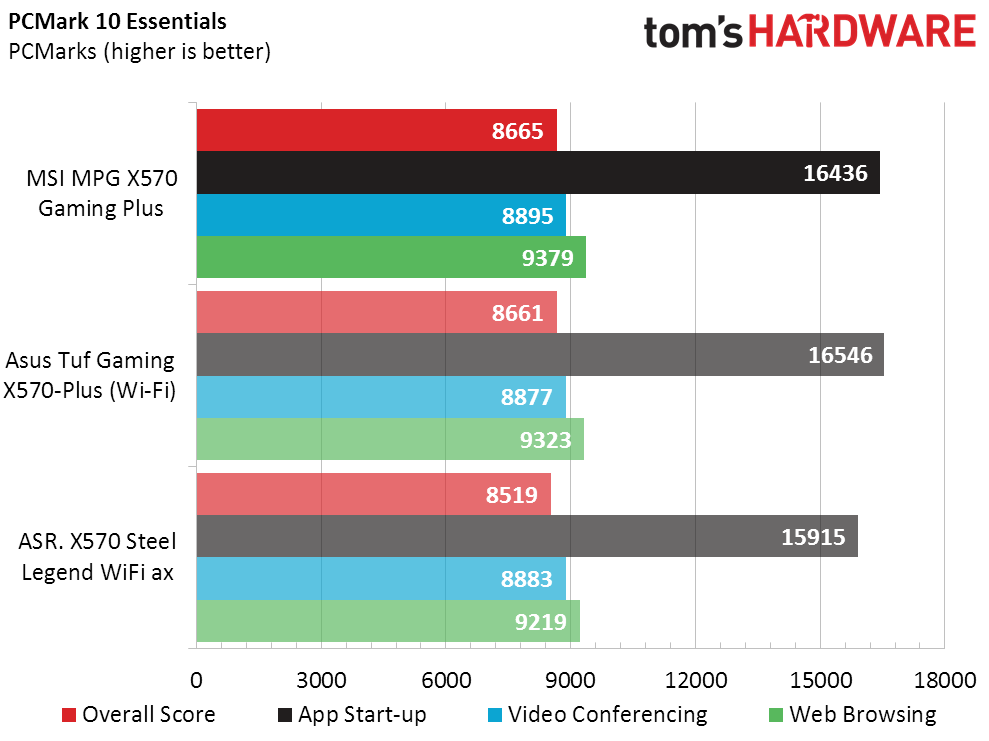

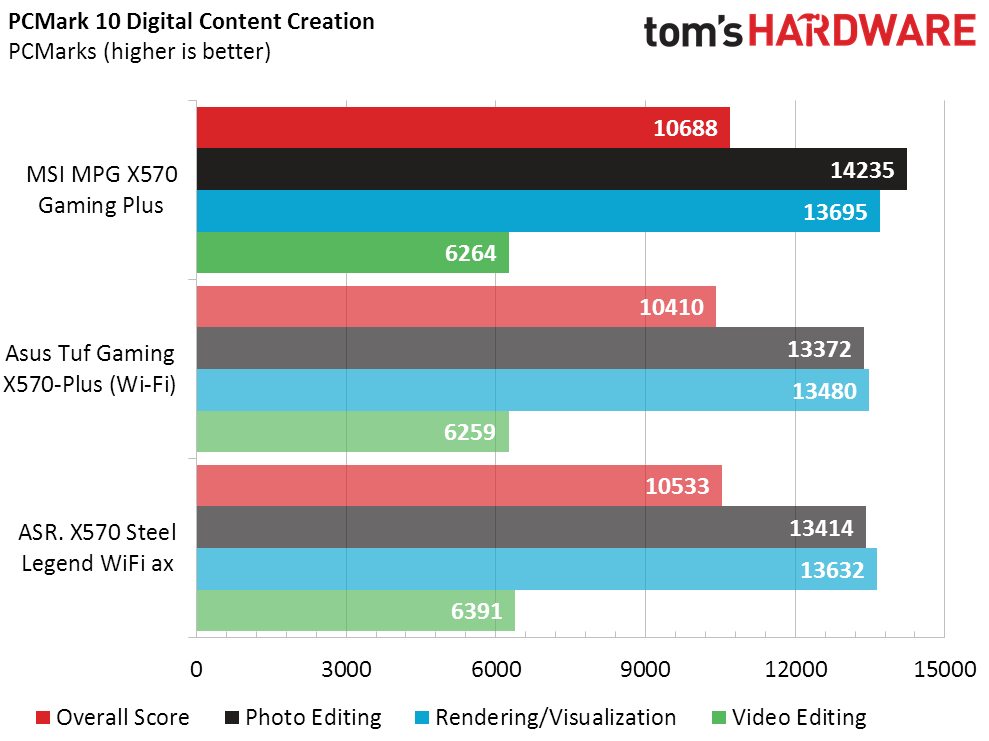

Though it appears unremarkable across most of our synthetics, the MPG X570 Gaming Plus pulled off a noticeable win in PCMark’s “Digital Content Creation.”
3D Games
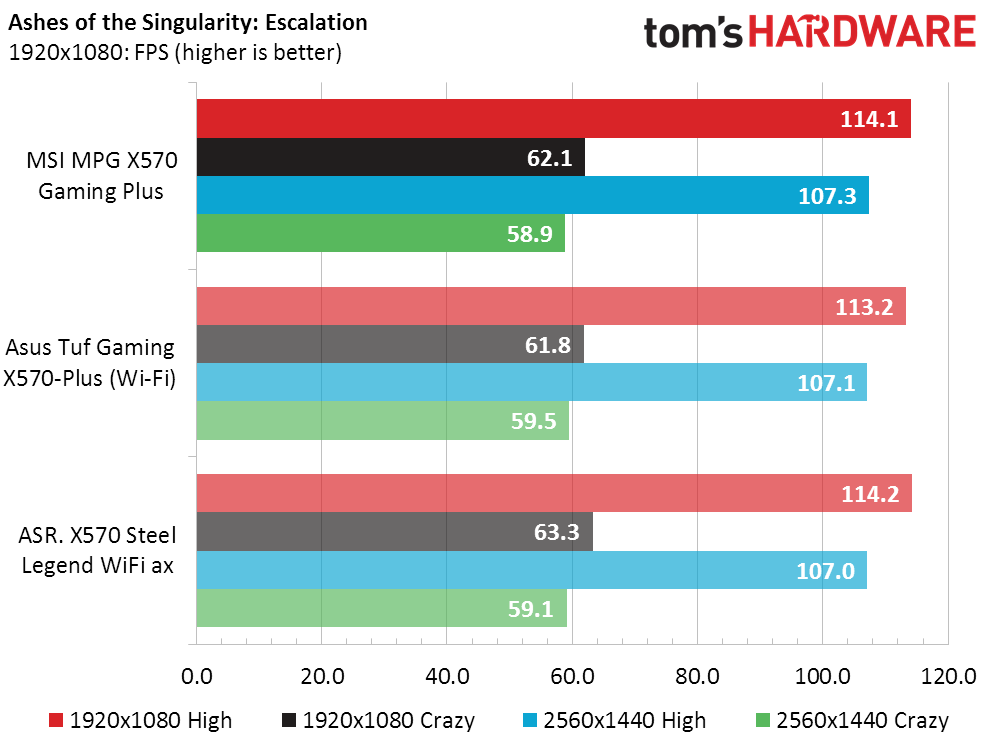

The MPG X570 Gaming Plus appears dead average in games. Considering it’s one of the cheapest X570 boards you can buy, that’s not a bad thing.
Mixed Workloads
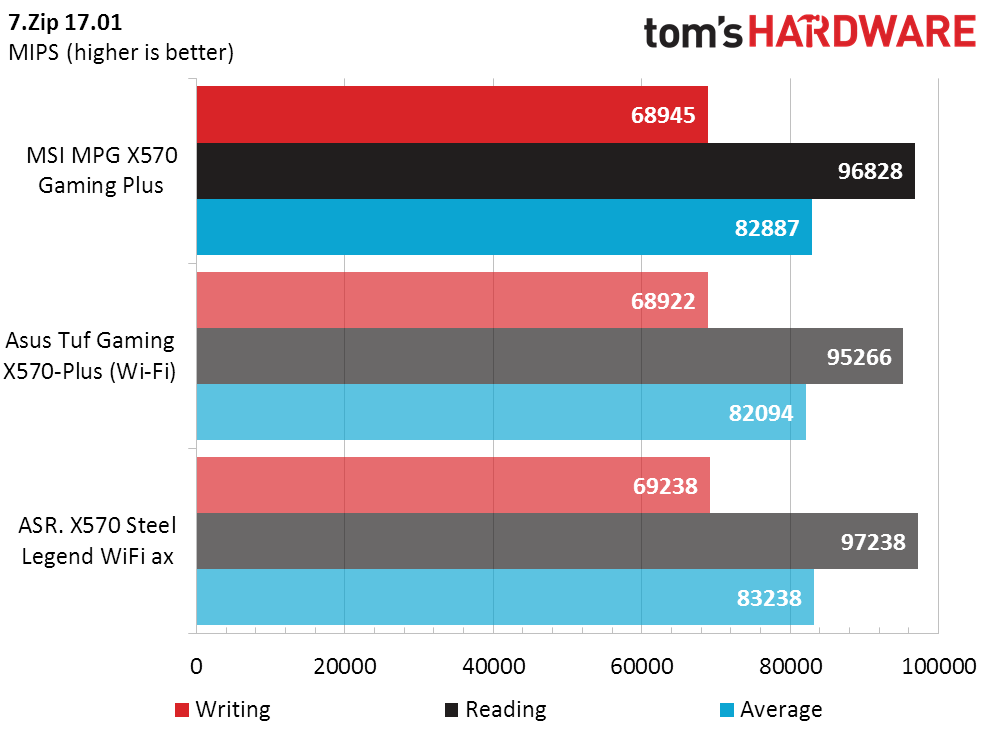

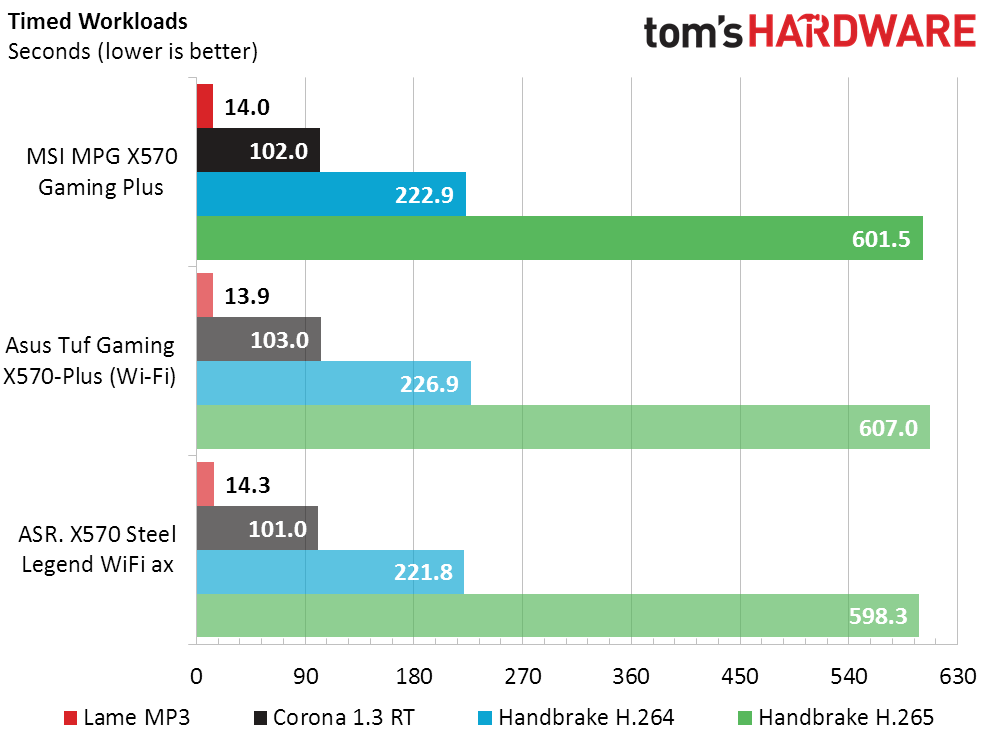
That all three boards offer similar performance in our various applications is a great indicator that these manufacturers aren’t cheating to win awards.
Power, Heat and Efficiency

The MPG X570 Gaming Plus consumed more power at full load, and even when we retested to look for the cause we weren’t able to get it to stay consistently less than 10W above its closest rival.
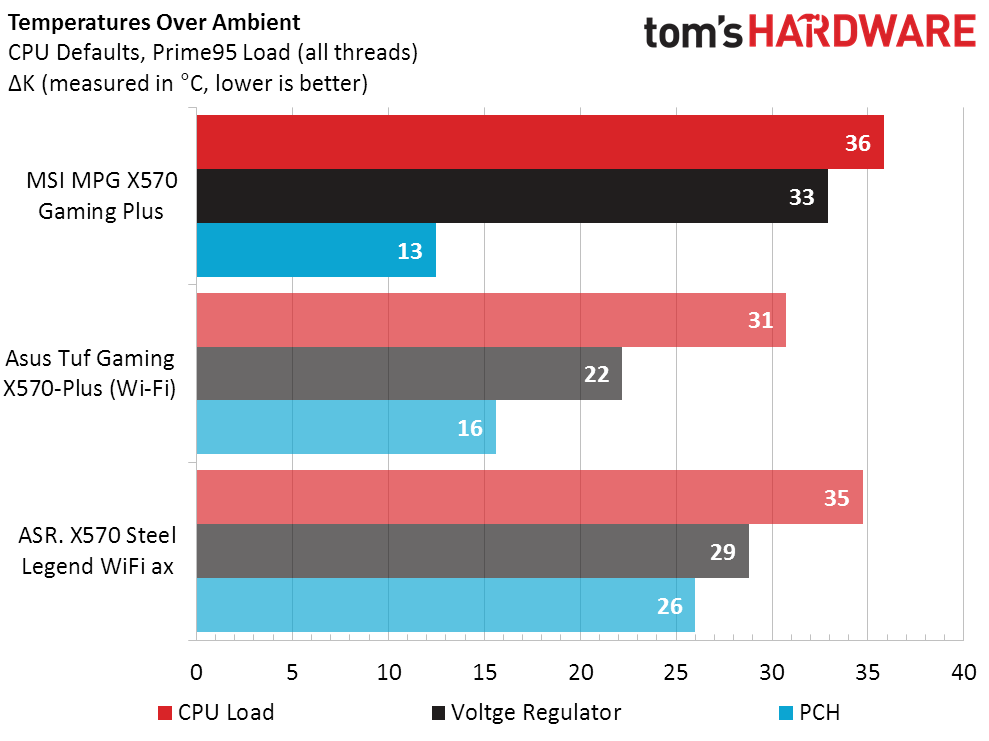
Our tests dispel the popular belief that MSI has hot voltage regulators: After getting even lower readings than this from an infrared thermometer, we loaded HWinfo to make sure that the hot parts weren’t simply being hidden from our sensor. This is the highest temperature we could find at stock clocks, and it even stayed below 90 degrees Celcius through our overclocking stress tests.
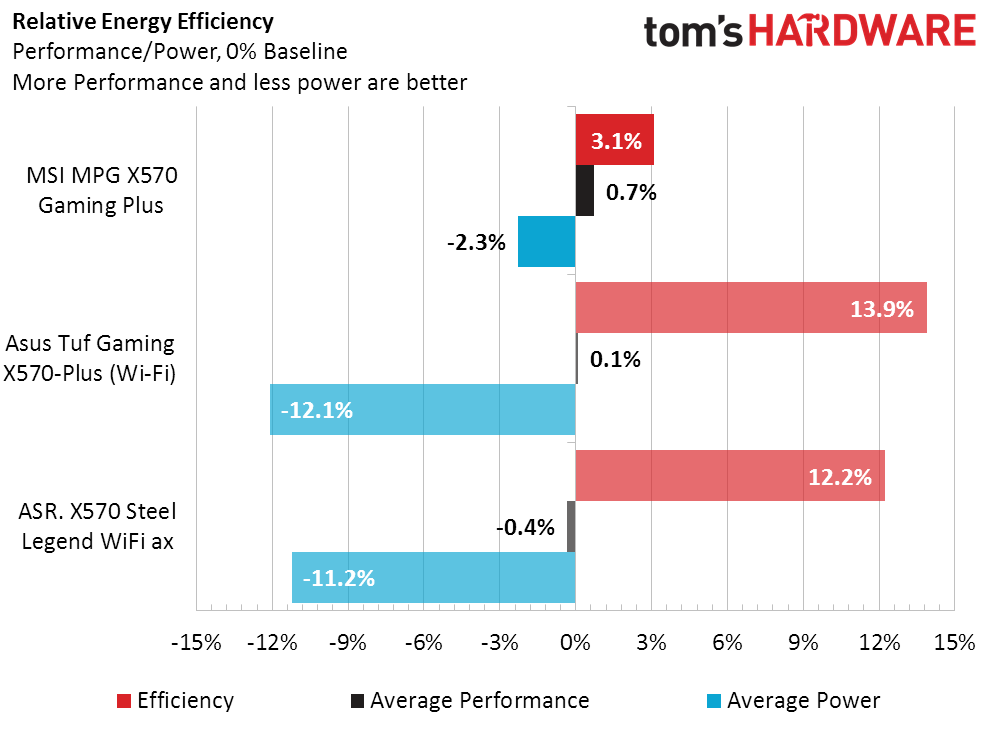
Using the performance and power results from our entire X570 review series makes all three sub-$200 motherboards appear efficient, if only because some of the high-end boards needed more power for their additional controllers. Still, the MPG X570 Gaming Plus is several percent less efficient than its other sub-$200 rivals.
Get Tom's Hardware's best news and in-depth reviews, straight to your inbox.
Final Analysis
The MPG X570 Gaming Plus performs roughly the same as most other X570 boards, so any price-to-performance analysis will make its low price stand out.
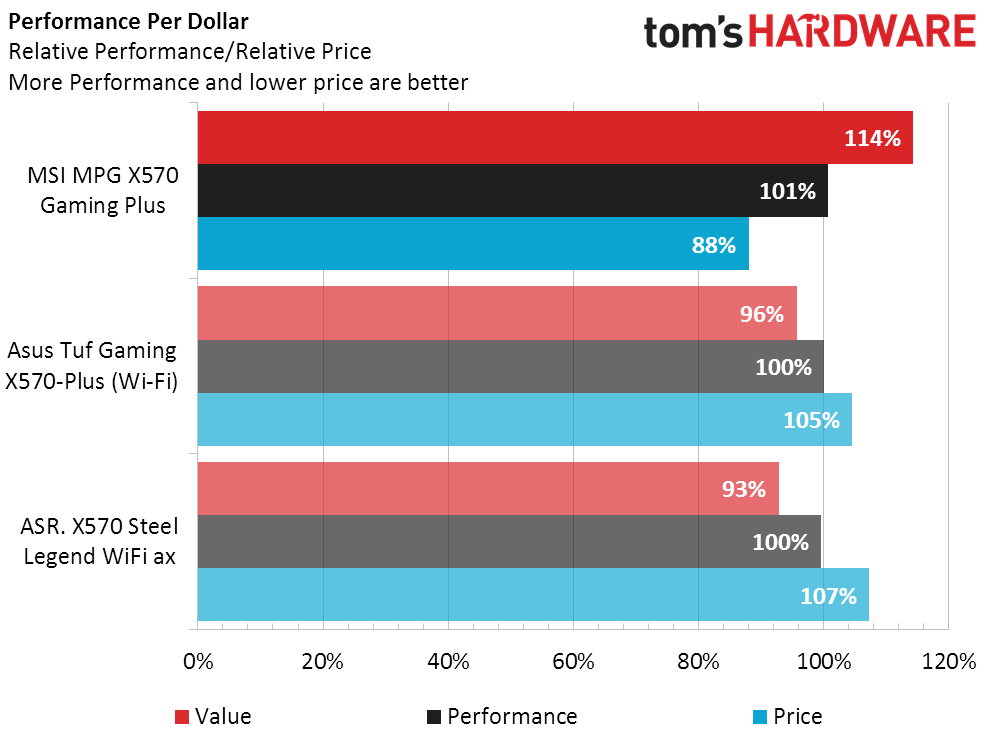
If we instead consider its $25 savings when compared to the Tuf Gaming X570 Plus (Wi-Fi), we could just as easily say that it has around $25 less worth. You could be paying for the more-expensive board’s even-larger CPU voltage regulator and onboard Wi-Fi controller. Or, perhaps you don’t need those things?
Most buyers in the sub-$200 motherboard market will never upgrade to the Ryzen 9 3950X, and few will even jump up to the 3900X, and hardly any buyers would expect boards in this price class to overclock those processors. When you’re mostly after the basics in an X570 board, so you can spend more on the processor or other components, the MPG X570 Gaming Plus is easy to recommend.
MORE: Best Motherboards
MORE: How To Choose A Motherboard
MORE: All Motherboard Content
Current page: Benchmark Results and Final Analysis
Prev Page Software, Firmware and Overclocking-
tennis2 So even X570 ATX boards still to this day have more physical expansion slots than they can sufficiently feed natively. This is why mATX should be king.Reply -
Crashman Reply
A bunch of graphics cards have coolers that are more than two slots thick. And most boards keep the top slot space vacant to make more room around the CPU, so that the second card would go into the case's fifth or sixth slot.tennis2 said:So even X570 ATX boards still to this day have more physical expansion slots than they can sufficiently feed natively. This is why mATX should be king. -
InvalidError Reply
How many people do you know will actually need more than one 4.0x4 slot for M.2? Linus recently did a side-by-side SATA3 vs 3.0x4 vs 4.0x4 "blind test" in general use and SATA actually won - even people in the hardware review business cannot reliably tell the difference in real-world use other than file copy.tennis2 said:So even X570 ATX boards still to this day have more physical expansion slots than they can sufficiently feed natively. This is why mATX should be king.
For most people, the flexibility of being able to pick between interface A or B for a given group of HSIO lanes without having to pay an exorbitant price premium for extra IO to support everything at once is far more valuable and you cannot cram all of that flexibility on a mATX board. Especially when two or even three out of four PCIe slots may be blocked off my the GPU alone as Crashman mentioned.
I have a mATX board in my current PC and regret that decision since it means I cannot have both my USB3 and FireWire cards (yes, I still occasionally use some FW stuff) installed at the same time since I have only one usable slot aside from the GPU. -
tennis2 Even with a dual slot GPU, most mATX boards still have 2 empty PCIe slots. Except, unlike ATX where "if you use this slot, this one gets disabled" doesn't come into play since you don't have more slots than can be simultaneously fed.Reply
I'm not saying ATX shouldn't exist, there's just no reason it should be the most common form factor anymore with all the built in IO and features that modern chipsets have. Not like back in the day where you needed an add-in card for even fairly common IO tasks. -
2Be_or_Not2Be ReplyInvalidError said:I have a mATX board in my current PC and regret that decision since it means I cannot have both my USB3 and FireWire cards (yes, I still occasionally use some FW stuff) installed at the same time since I have only one usable slot aside from the GPU.
Wait, are you saying that you have a USB3 add-in card? I think you might need a new m/b, not more slots in that old one. ;)
Kidding aside, I do think that mfgs still make way too many full-size ATX and not enough micro-ATX/mini-ITX. I think multi-GPU setups have been waning in popularity, whether due to lack of return in cryptomining or just the overall higher expense of multiple high-end GPUs without a corresponding linear increase in performance. Yet we don't see more micro-ATX, ITX, or even DTX boards; we see the same large amount of ATX/eATX.
I personally only need a mini-ITX board (YMMV, of ocurse), and I would love to see more options available in that space. -
Crashman Reply
I already explained it to you. With the hardware these guys want, the second card has to go into the case's fifth or sixth slots. Now, you go tell the motherboard companies they can't push the top slot down into the second space. And while you're at it, tell the graphics card companies that all cards must be at most two spaces thick.tennis2 said:Even with a dual slot GPU, most mATX boards still have 2 empty PCIe slots. Except, unlike ATX where "if you use this slot, this one gets disabled" doesn't come into play since you don't have more slots than can be simultaneously fed.
I'm not saying ATX shouldn't exist, there's just no reason it should be the most common form factor anymore with all the built in IO and features that modern chipsets have. Not like back in the day where you needed an add-in card for even fairly common IO tasks.
I don't have to like it, I need only be realistic. -
InvalidError Reply
A new motherboard wouldn't help since most modern boards still only have six USB ports at the back. One of those would still get dedicated to my UPS, three of them would still go to my USB hubs for convenient access to USB ports (my computer is deep under my desk, so using front-panel ports is a non-option), mouse and keyboard fill in the rest.2Be_or_Not2Be said:Wait, are you saying that you have a USB3 add-in card? I think you might need a new m/b, not more slots in that old one. ;)
So, even if I upgraded my PC, chances are I'd still toss an USB3 card in for 2-4 extra ports so I can leave everything permanently wired in without daisy-chaining hubs. -
Ncogneto Replyadmin said:Our search for the best deal in 3rd Generation Ryzen processor support led us to MSI’s MPG X570 Gaming Plus. Is it a deal or should you look elsewhere for X570 options?
MSI MPG X570 Gaming Plus Review: Affordable Basics : Read more
Welcome to Tom's hardware, Were we stress test a motherboard with a 65w CPU.
Seriously?
"Most buyers in the sub-$200 motherboard market will never upgrade to the Ryzen 9 3950X, and few will even jump up to the 3900X, and hardly any buyers would expect boards in this price class to overclock those processors. When you’re mostly after the basics in an X570 board, so you can spend more on the processor or other components, the MPG X570 Gaming Plus is easy to recommend."
What kind of crap is that? Does it say on the box "does not support Ryzen 3900 or 3950x?
Tom's Hardware used to be a great place to go for good reviews. Now they are just pandering to there sponsors.
tsk tsk. -
Crashman Reply
Tom's Hardware used to be a great place to go for feedback. We tested this CPU up to 230W via overclocked stress tests. The 3950X TDP is 105W. Reading instead of skimming could be helpful..tsk tsk ;)Ncogneto said:Welcome to Tom's hardware, Were we stress test a motherboard with a 65w CPU.
Seriously?
"Most buyers in the sub-$200 motherboard market will never upgrade to the Ryzen 9 3950X, and few will even jump up to the 3900X, and hardly any buyers would expect boards in this price class to overclock those processors. When you’re mostly after the basics in an X570 board, so you can spend more on the processor or other components, the MPG X570 Gaming Plus is easy to recommend."
What kind of crap is that? Does it say on the box "does not support Ryzen 3900 or 3950x?
Tom's Hardware used to be a great place to go for good reviews. Now they are just pandering to there sponsors.
tsk tsk. -
Ncogneto Reply
"Most buyers in the sub-$200 motherboard market will never upgrade to the Ryzen 9 3950X, and few will even jump up to the 3900X, and hardly any buyers would expect boards in this price class to overclock those processors. When you’re mostly after the basics in an X570 board, so you can spend more on the processor or other components, the MPG X570 Gaming Plus is easy to recommend."Crashman said:Tom's Hardware used to be a great place to go for feedback. We tested this CPU up to 230W via overclocked stress tests. The 3950X TDP is 105W. Reading instead of skimming could be helpful..tsk tsk ;)
Seriously?
https://www.google.com/search?q=running+a+3900x+on+MSI+MPG+X570+Gaming+Plus&client=opera&hs=4IO&sxsrf=ALeKk00M7YkDWWnsoNBQbLEnqD3waTbylA:1582340287937&ei=v5hQXoHbOIy2swWp0JrQCA&start=10&sa=N&ved=2ahUKEwjBtpr2lOTnAhUM26wKHSmoBooQ8tMDegQIDBAz&biw=3440&bih=1368
_7PkZwY9PWMView: https://www.youtube.com/watch?v=_7PkZwY9PWM
_7PkZwY9PWM:672View: https://www.youtube.com/watch?v=_7PkZwY9PWM&t=672s
Has a bios revision corrected these problems? They have been duplicated on numerous other sites.
But seriously, how can you recommend this board when other boards do much better.......
